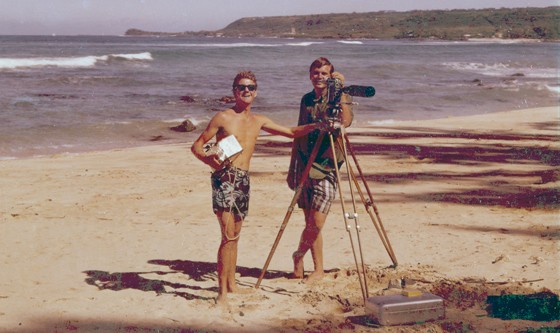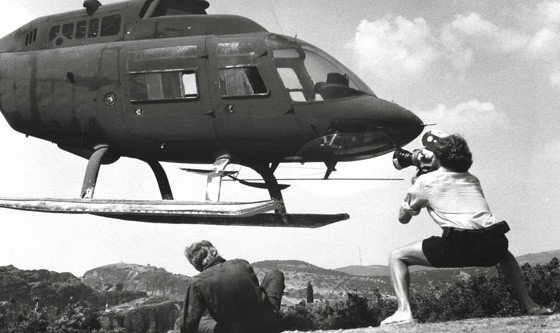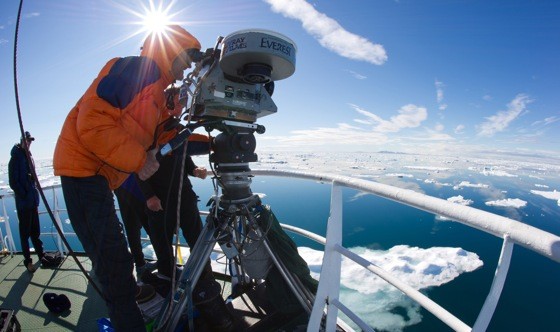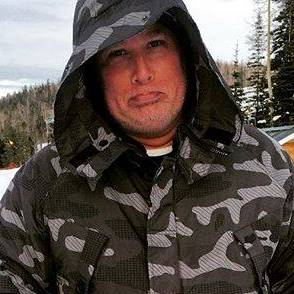
MacGillivray Freeman Films, the Laguna Beach makers of some of IMAX's most successful documentaries including Everest, The Living Sea and the upcoming Journey to the South Pacific, is celebrating its 50th year in the biz. That milestone is actually being celebrated with events at the Newport Beach Film Festival this evening and Wednesday night.
]
NBFF Recommendation of the Day: Five Summer Stories
To honor the 50th anniversary ourselves, we present 50 quotes from a recent interview with company co-founder Greg MacGillivray, the first documentary filmmaker to earn more than $1 billion in ticket sales at the worldwide box office. Take it away, maestro …
1) “I started out doing surfing films back as a high school kid, and the times then it was just non-commercial moviemaking, just for the fun of it.”
2) “I made three films for Newport Harbor High School [his alma mater]. Two were a half hour long and showed the times around our campus. Just about all of it was shot in hidden-camera/home-movie style, kind of goofing around. I wanted to get a feeling of the campus and the people and the teachers. It was all shot with a telephoto lens and hidden-camera techniques. The third was a scripted, seven-minute film for the drama department.”
3) “I loved projects. That's what really gets me excited. If it can include other people, great. Or it can just be me and no money to pay other people. Back then, if I needed an actor, I'd get someone from the drama department or my girlfriend Barbara to be in a shot and do something funny.”
4) “I wasn't really a total geek but I was certainly on the geekish side. I loved math, physics, I loved drafting and art. I studied physics in college but filmmaking was really my intention.”
5) “Those years, because I was just doing it all alone–there were no employees; I did not even know many people–it was a complete joy. You just depended on yourself.”
6) If you got up early and checked the surf, you might get lucky” and find something to shoot. “If I missed a day good waves, if I did not film it or didn't take advantage of the great weather, the offshore wind or terrific conditions, I'd be depressed.”
7) “Offshore winds, which only arrived every three months or so, were ideal because they made the waves look that much prettier. They are fringed with white on top. It's one of the prettiest things in nature.”
8) “It was a complete shock when the first film came out” while in college “that actually made a profit, to me and my parents, sisters and everyone. Then it tripled and quadrupled the money that had been invested and I recognized I could actually turn this into a career.”
9) “When Jim Freeman and I started working together [in 1966], now there were two people and I had a friend to feel the joy with or we'd both be down because we missed a day” of good surf. “It was different.”
10) Today's surf films are “hard to watch. … There are so many. Most are about certain contests or the pro surfers or are made by surf trunk companies. I watched one of those the other day. They are well done, but they are different than the surfing films of the '60s.”
11) “Back then you'd go to theaters to see them. You'd be waiting six months for the thing to come out. It would be a big date to go out and watch a surf film. All your surf friends were there. It was a big cultural event–the only cultural event because there were not even surf contests back then.”
12) “It was the way surfers shared ideas, talking about fins and surfboard shapes and whether you've ever gone to Mexico to surf. There were not the easy ways of communication we have today. Nowadays it is either on the Internet or in a magazine and everyone has been everywhere around world surfing. They'll know which tide and what time of year it breaks in Chile. It's stunning how much information there is out there today. There is no mystery. In the '60s, everything was a mystery.”
13) He and Freeman's “subtitle for Five Summer Stories [1972] was 'The Last Surfing Movie,' a play on The Last Picture Show that came out a year earlier. After we finished Five Summer Stories, we decided that was going to be our final surfing movie.”
14) “We had invested our hearts and souls into surf films, but by then we were already working in Hollywood and being offered assignments to produce and make special sequences” in movies like The Towering Inferno and Jonathan Livingston Seagull.
15) “Jim and I said, 'We can't tell the story any better or any differently; let's move on to something else.' It's not as much fun doing the same thing over and over and over. We started challenging ourselves with other kinds of films.”
16) “We kept getting these assignments to produce certain things for films with huge budgets. These were really inventive filmmakers, so we figured we could learn from them.”
[

17) “We started doing a lot of work. A lot of people were champions of our little company. By that time Jim and I could employ our girlfriends Barbara [now MacGillivray's wife] and Jim's girlfriend Cindy.”
18) “We worked so hard: nine, 10, 11, 12 hours a day, seven days a week. We didn't take a vacation until after our company was 10 years old. We just loved making movies. That was us.”
19) When Freeman died in a helicopter crash in 1976 while filming a commercial, “I thought my life had ended, too.”
20) Director and co-writer John Milius “hired me to produce mostly all the surfing sequences [in 1978's Big Wednesday]. … It was hokey back then. It's interesting to see it now. It looks less hokey now than it did back then. It seems nostalgic and retro in a way than it did not then. Time has been good to it.”
21) For the Stanley Kubrick horror classic The Shining (1980), “There were new technologies we invented and Kubrick loved it. There was one experimental shot we ran by Stanley in London, and he loved it. So we went out and shot it. That's the way it was.”
22) The Shining “still holds together. It's scary, but it was a lot of fun. I have friends who say it's too scary.”
23) The recent documentary Room 237, which presented theories The Shining was really about the Holocaust, a faked Moon landing and the American Indian genocide, “is mainly fabricated. It's hokey. It's one of those things where a couple of things are probably accurate, but the other 20 things are not.”
24) With 35 MacGillivray Freeman Films employees currently “you have to be a bit more organized. We now plan things out months in advance. For some shoots, we have to build new cameras to do what the mind sees. It's a lot more cumbersome but still fun. The inventive side is still there.”
25) “Just because there are 35 people, it doesn't mean things turn out worse. They might turn out quite a bit better. But you do spend a lot more money.”
26) “There are always those things you miss out on” while filming in nature, “but they are always replaced by things you luck into.”
27) “Sometimes we start with one theme and end up with a completely different one, even something tragic. While we were making Everest, eight people died. While we were filming, our team tried to save a number of people. It became part of the story and made the film better.”
28) “I am always so passionate while making a movie. I think that's the joy of it.”
29) “The process is always the same: research, doing casting, finding locations, finishing it, doing music. The subjects always shift radically. It's like falling in love as you're doing it. It's a complete turn on.”
30) “It's absolute immersion in creativity, trying to combine great research and knowledge of a subject with the creative process of filmmaking, music and feelings. I've never found anything that is as much fun.
31) “I have been so lucky to have been able to do this. I think a lot of it is luck.”
32) Regarding 2012's To the Arctic: “I hate cold weather.”
[

33) “I went up there five times to shoot. On the last scheduled shoot, the whole script changed. We had a mother polar beat and her two cubs with us for five-and-a-half days. We got enough footage those days to change the entire movie. It was such good footage.”
34) “She was like a trained animal around us, so confident. All the rest of the polar bears would run away if we came up near them and disappear. This one came up, sniffed us, went 'OK, I know they are not going to kill or hurt me and I can use them as cover.'”
35) “The captain of the ship said she knew she would not have to expend valuable energy running away from us. The mother polar bear was the smartest bear the captain had ever seen. Every decision she made showed this, the way she caught seals for her cubs, her good swimming. She was good at being on the alert all the time.”
36) “The two cubs were also so comfortable being around us.”
37) “We'd be shooting 24 hours a day, all day long and all night long. That was cool, But it changed that movie around. We had to re-edit everything. We threw away a lot of stuff.”
38) “With our IMAX films that even have a conservation message, they are generally pretty non-accusatory. We try not to make people feel guilty. But we try to get people to think about things differently and dig deeper.”
39) “Climate change was an issue in To the Arctic, because that location is suffering faster and worse than anywhere else on the planet. Sea levels are rising. The thing that is really valuable and important to me is people who watch the movie get the message and take it a little further. Go to the Internet or our website or get a book about it and get intrigued. And fall in love with the polar bears because we don't want them to disappear.”
40) “My friend [the late] Mike Marshall had something to do with” Living It Forever, a documentary about the early days of surfing in Newport Beach that played at 2010 Newport Beach Film Festival. “I gave them all my footage.”
41) “I gave them some surfing footage from the Corona del Mar jetty and Newport Beach in the early 1960s. That was a lot of fun.”
42) Regarding the Newport Beach Film Festival: “I love it. I think Newport Beach is a good location for this. It is close enough to Hollywood, and there is a huge interest in film in our community. With UC Irvine being here there is such an interest in education and learning. People are film savvy here.”
43) “Another thing is the people who run the festival have done such a good job selecting good quality films and making good events out of them. The events are more stimulating and informative; you're not just sitting there watching a movie. People talk about films. It makes it a very active, hip thing.”
44) “I think the festival has all been very good for film. I don't see a danger in it stopping. It's been such a huge success for very strong reasons. I see it continuing.”
45) Regarding whether his festival events will be a case of “hometown boy does good:” “Maybe. I just don't think that way, I just work all the time. I'm proud that my team and I have been able to take global audiences on new adventures for 50 years, and that our films have had such a positive impact around the world.”
46) “It delights us to no end that we can celebrate right here in our own backyard with our colleagues and friends.”
47) “Whatever accolades come from making films is fun, I like meeting new people, the actual events are fun. But, really, the biggest joy I get is watching people watch my movies and seeing their response to the film. That's the joy. Getting an award is not that important to me. I don't think it is for most filmmakers.”
48) “The struggle you've gone through to make a movie and have it actually have an impact on people to change the way they think when they get home or even drive them to pick up a book to investigate further, that's the motivation I'm really after.”
49) “I find new inspiration when I get up in the morning. Maybe I can't solve that [problem], maybe I can. That's the fun of it. That's what I've enjoyed.”
50) The past 50 years “does seem like a blink of an eye; it's shocking that way. When you put your nose to the grindstone and churn out movies and love doing it, life goes by very quickly.”
The Newport Beach Film Festival presents Five Summer Stories at 5 p.m. at South Coast Village Theater in Santa Ana. A panel discussion follows the screening with surfing luminaries Laird Hamilton, Gerry Lopez, Herbie Fletcher, Pete Townend and Steve Pezman, who discuss the documentary's impact and the dramatic changes in surf culture since the 1970s.
The NBFF presents MacGillivray Freeman Films Retrospective at 7:30 p.m. Wednesday at the Regency Lido Theatre in Newport Beach. MacGillivray leads a multi-media presentation with film clips and tales from his most memorable filmmaking expeditions, culminating with the Orange County premiere of his newest film Journey to the South Pacific, which is about a young boy's adventures amid the islands of West Papua and was originally produced for IMAX theaters.
Look for a story on the 50th anniversary of MacGillivray Freeman Films, with more on working with Stanley Kubrick, in this Thursday's OC Weekly print edition.

OC Weekly Editor-in-Chief Matt Coker has been engaging, enraging and entertaining readers of newspapers, magazines and websites for decades. He spent the first 13 years of his career in journalism at daily newspapers before “graduating” to OC Weekly in 1995 as the alternative newsweekly’s first calendar editor.

